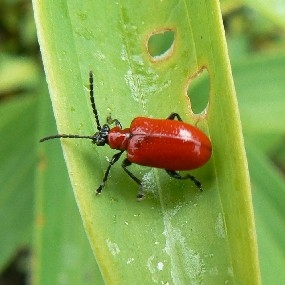I’m Charlie Nardozzi and this is
the Vermont Garden Journal. For years lilies have been the carefree darlings of many perennial gardens. But then
came the red lily leaf beetle. This European native found its way to Massachusetts
in 1992 and has been spreading around New
England ever since. If you grow Asiatic, Oriental, or Turk’s cap
lilies or fritillaria bulbs, you know these beetles. Daylilies, luckily, aren’t
affected.
The overwintering bright red adults emerge to feed in spring as soon
as your lily plants start growing. In May they start laying bright orange eggs
on the underside of the leaves. The eggs hatch within 1 week and the black,
slug-like larvae start feeding. What’s even worse is the larvae pile their own
excrement on their back as a defense mechanism. Yuck. The larvae feed for up to
3 weeks causing damage to lily leaves, buds, and flowers.
To control these dastardly beetles
you need diligence. Hand pick and kill the adults. Spray Neem oil or spinosad
organic controls once you see signs of the eggs. These controls are most
effective against the young larvae and will need to be reapplied weekly after
eggs are spotted.
Now for this week’s tip, looking
for something wild to eat? Why not trying stinging nettles? Nettles are highly
nutritious and make a great, dark green colored, mild tasting spring soup. With
gloves, carefully hand pick the tops of young nettle plants found in abandoned
fields. The "sting" in nettle leaves is neutralized when you cook it.
Go to VPR dot-net for tips on identifying stinging nettle plants and for my
soup recipe.
Next week on the Vermont Garden
Journal, I’ll be talking about lilacs. For now, I’ll be seeing you in the
garden!
Non-Dairy Cream of Nettle soup recipe:
Ingredients:
4 tablespoons olive oil or butter
1 cup chopped onion
3 quarts fresh nettle leaves
5 medium sized potatoes cut into 1 inch cubes
2 cups vegetable stock
4 cups water
1 teaspoon salt
black pepper to taste
Heat butter or olive oil in 4 quart saucepan. Add shopped onions and cook until transparent. Add potatoes, stock, water and salt. Simmer until potatoes are soft. Add nettle leaves, cover pot and simmer 5 to 10 minutes until cooked. Pour mixture a little at a time into a blender or food processor and blend until smooth. Return to saucepan and reheat slowly. Serve hot or cold.
